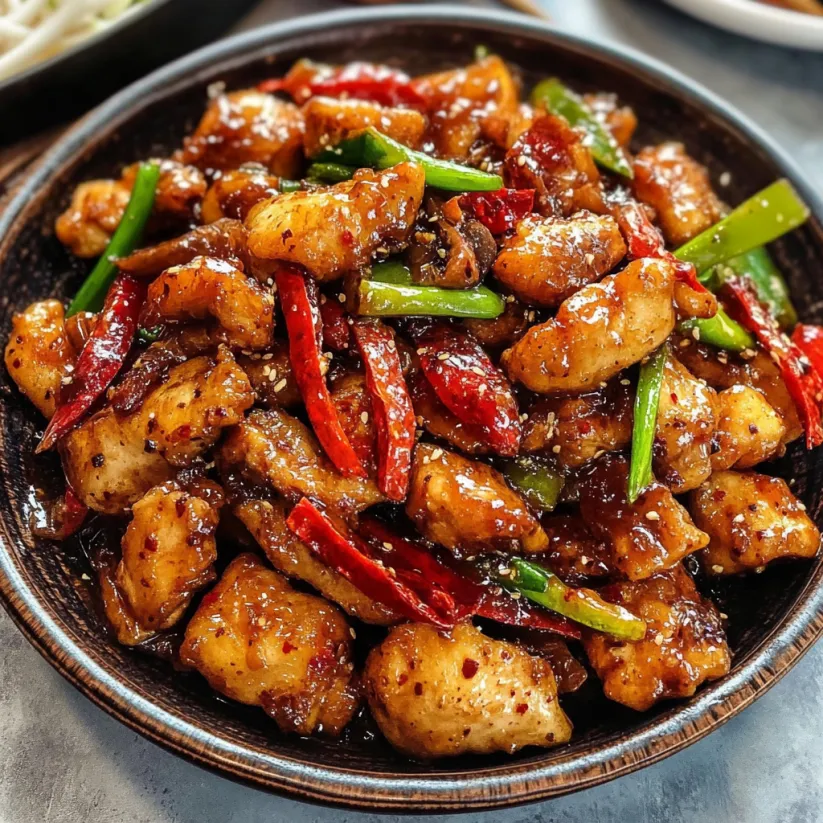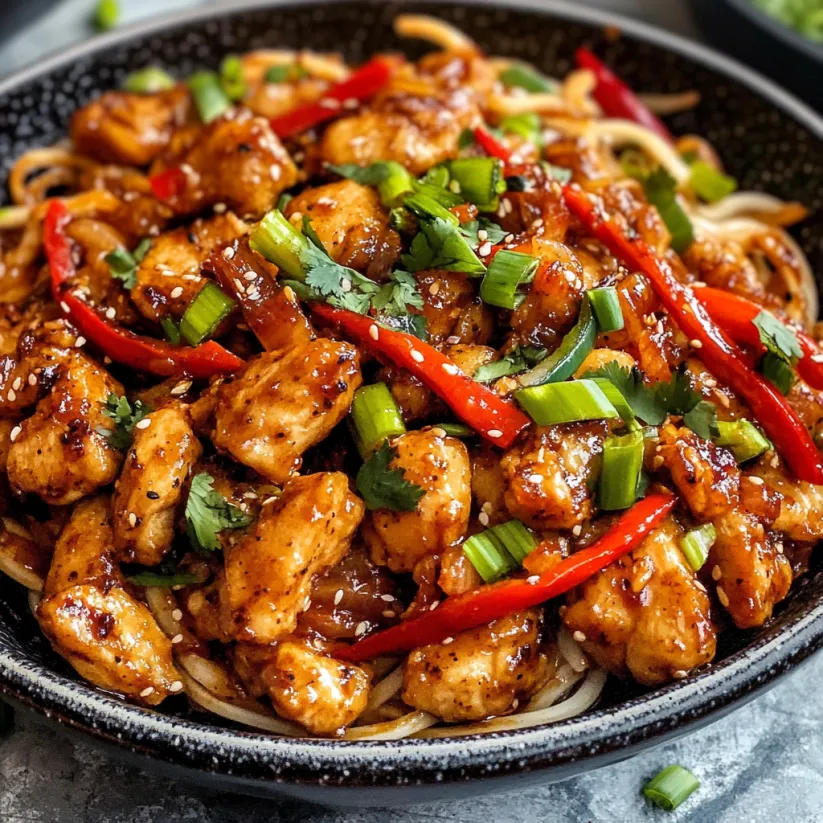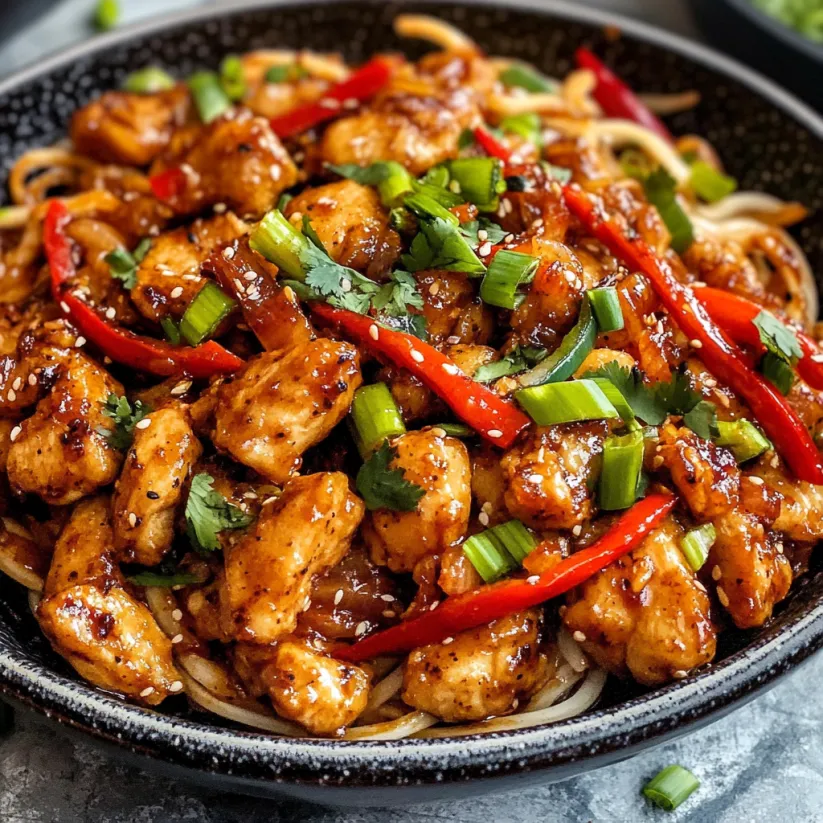 Save Pin
Save Pin
This hearty Szechuan chicken has become my go-to recipe when I'm craving authentic Chinese flavors without waiting for delivery. The perfect balance of spicy, tangy, and savory elements creates that unmistakable numbing heat that makes Szechuan cuisine so addictive.
I first made this recipe during a snowstorm when takeout wasn't an option. My family was so impressed they claimed it was better than our favorite restaurant version. Now it's requested at least twice a month in our home.
Ingredients
- Chicken breast cubes: cutting them uniformly ensures even cooking and perfect texture
- Soy sauce: the foundation of the umami flavor profile; choose low sodium for better control
- Shaoxing wine: adds authentic depth and complexity to both marinade and sauce
- Sesame oil: brings that distinctive nutty aroma that elevates the entire dish
- Cornstarch: creates that signature crispy coating when properly applied to the chicken
- Bell peppers: add sweetness and color; choose firm ones with glossy skin
- Sichuan peppercorns: the star ingredient providing the signature numbing sensation
- Dried red chilies: control the heat level by adjusting quantity and removing seeds
- Fresh ginger and garlic: aromatic foundations that must be fresh, not pre-minced
- Black rice vinegar: adds complex tanginess; look for Chinkiang variety if possible
Step-by-Step Instructions
- Prepare the sauce:
- Combine all sauce ingredients in a small bowl and whisk thoroughly until the cornstarch is completely dissolved. The sauce should have a smooth consistency with no lumps. This preparation allows the flavors to begin melding while you work on other components.
- Marinate the chicken:
- Place chicken cubes in a bowl with soy sauce, Shaoxing wine, and sesame oil. Toss thoroughly to coat each piece evenly and let it rest for exactly 10 minutes. This brief marination time is crucial as it flavors the meat without making it too salty or affecting the texture.
- Coat with cornstarch:
- Sprinkle cornstarch over the marinated chicken and use your hands or tongs to ensure each piece is thoroughly coated. The cornstarch layer should be thin but complete with no bare spots. Shake off excess for the perfect crispy exterior.
- Fry the chicken:
- Heat oil to exactly 325°F in your wok. If you don’t have a thermometer, watch for slight rippling but not smoking. Add chicken in batches, being careful not to overcrowd which would drop the temperature and result in soggy coating. Fry until golden brown and crisp, approximately 3 to 4 minutes per batch. Drain properly on paper towels.
- Stir fry aromatics and vegetables:
- Clean your wok and add fresh oil over high heat until it just begins to smoke. Add onions first, cooking for one minute until slightly softened but still crisp. Follow with bell peppers, dried chilies, garlic, ginger, and the crushed Sichuan peppercorns. Maintain high heat and keep everything moving constantly to prevent burning.
- Combine and finish:
- Return the crispy chicken to the wok and immediately pour the sauce over everything. Toss continuously for exactly one minute allowing the sauce to thicken and coat every piece. The sauce should transform from translucent to slightly glossy as the cornstarch activates in the heat.
 Save Pin
Save Pin
The Sichuan peppercorns are truly magical in this dish. I remember my grandfather who lived in Sichuan province teaching me that these aren’t actually peppers but the dried berries of the prickly ash tree. He would crush them between his fingers to release their citrusy aroma before adding them to dishes, explaining that this step unlocks their full potential.
Storing Leftovers
If you happen to have leftovers, which rarely happens in my home, store the chicken and sauce separately whenever possible. Keep refrigerated in airtight containers for up to three days. The chicken will inevitably lose some crispness, but the flavor remains outstanding. When reheating, use a wok or skillet over medium-high heat rather than the microwave to restore some of the textural contrast. Add a small splash of chicken broth if the sauce has thickened too much during storage.
Ingredient Substitution Guide
Don’t have all the authentic ingredients? No problem. While traditional components create the most authentic flavor, several substitutions work surprisingly well. Instead of Shaoxing wine use dry sherry or even a bit of rice vinegar with a pinch of sugar. Regular rice vinegar can replace black rice vinegar, though you’ll miss some depth. If you can’t find Sichuan peppercorns, black pepper with a touch of lemon zest provides a different but pleasant heat profile. For those avoiding cornstarch, potato starch or arrowroot make excellent alternatives for both the marinade and sauce thickening.
Balancing The Heat
The beauty of homemade Szechuan chicken is controlling the spice level precisely to your preference. For maximum authentic heat, toast whole Sichuan peppercorns until fragrant, then crush them immediately before adding to capture those volatile oils. Leave seeds in the dried chilies and increase their quantity for serious spice lovers. For a milder version, remove all seeds from chilies or substitute with milder peppers like Korean gochugaru. The numbing sensation from Sichuan peppercorns can be adjusted independently from the chili heat, allowing you to find your perfect balance of these two distinct sensations.
 Save Pin
Save Pin
Commonly Asked Questions
- → What makes Szechuan Chicken spicy?
Szechuan Chicken gets its distinctive spiciness from two key ingredients: dried red chilies and Szechuan peppercorns. The dried chilies provide traditional heat, while the Szechuan peppercorns deliver a unique numbing sensation (called 'ma' in Chinese cuisine) that creates the characteristic tingling feeling on your lips and tongue. Toasting the peppercorns enhances their citrusy aroma and intensifies this special numbing quality.
- → Can I substitute any ingredients in this Szechuan Chicken?
Yes, several substitutions work well: use chicken thighs instead of breast for more flavor and moisture; replace Shaoxing wine with dry sherry or mirin; substitute black rice vinegar with regular rice vinegar plus a touch of soy sauce; and if you can't find Szechuan peppercorns, use a mix of black pepper and ground coriander (though the distinctive numbing quality will be missing). For a milder version, reduce or omit the dried chilies.
- → How do I get the chicken extra crispy?
For extra crispy chicken, ensure these key steps: thoroughly pat the chicken pieces dry before marinating; make sure each chicken piece is well-coated with cornstarch but shake off excess; use oil at the correct temperature (325°F) - too low and the chicken absorbs oil, too high and it burns before cooking through; fry in small batches to prevent overcrowding which causes steaming instead of frying; and briefly drain on paper towels before adding to the stir-fry.
- → What can I serve with Szechuan Chicken?
Szechuan Chicken pairs perfectly with steamed jasmine rice or plain noodles that help balance its bold flavors. For a complete meal, add sides like a cooling cucumber salad with rice vinegar dressing, stir-fried bok choy or Chinese broccoli, scallion pancakes, or simple vegetable spring rolls. A light soup like egg drop or hot and sour would also complement this spicy main dish nicely.
- → How can I make this dish without a wok?
A large, heavy-bottomed skillet or frying pan works well as a wok alternative. The key is getting the pan very hot before adding ingredients. For frying the chicken, use a deep, heavy pot like a Dutch oven for safety and temperature control. When stir-frying the vegetables and combining everything, work in smaller batches if using a skillet to maintain high heat and prevent steaming. Cast iron pans are excellent alternatives as they retain heat well.
- → How do I adjust the spice level of Szechuan Chicken?
To reduce spiciness, deseed the dried chilies (or use fewer), decrease the amount of Szechuan peppercorns, or substitute with black pepper for milder heat. For extra spice, add fresh sliced chilies along with the dried ones, increase the Szechuan peppercorn amount, or include a teaspoon of chili oil in the sauce. You can also serve chili oil or chili crisp on the side so each person can customize their spice level.
